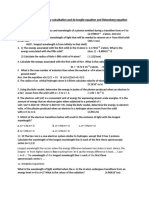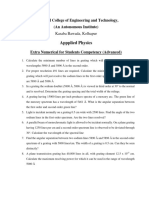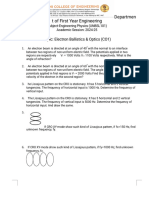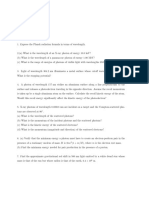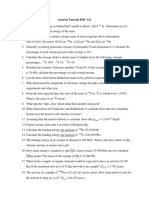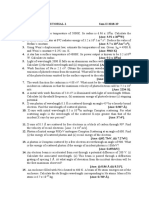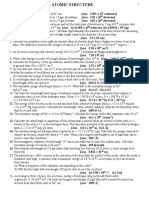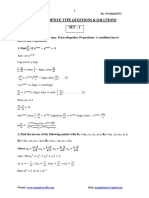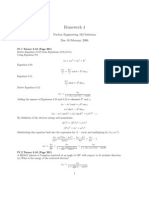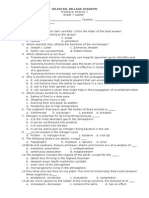Problem On Paricle Accelerators
Problem On Paricle Accelerators
Uploaded by
Nikhil YenumulaCopyright:
Available Formats
Problem On Paricle Accelerators
Problem On Paricle Accelerators
Uploaded by
Nikhil YenumulaOriginal Description:
Original Title
Copyright
Available Formats
Share this document
Did you find this document useful?
Is this content inappropriate?
Copyright:
Available Formats
Problem On Paricle Accelerators
Problem On Paricle Accelerators
Uploaded by
Nikhil YenumulaCopyright:
Available Formats
ASSIGNMENT- I
1. Calculate the frequency of the electric field that must be applied between the dees of a
cyclotron in which (i) proton (ii) deuteron (iii) alpha- particles accelerated. The
applied magnetic flux is 3.5 Wb/m2
2. In certain proton-synchrotron, a proton with an initial energy of 9 MeV is accelerated
to 10 GeV, gaining on the average an energy of 2.2 keV/tum. The total length of the
stable orbit inclusive of the straight sections is 100 m. The acceleration time 3.3 sec.
(i) Determine number of revolutions and path lengths covered by protons in the
whole period of acceleration.
(ii) What is final velocity of protons?
3. Calculate (i) the minimum velocity for the emission of Cerenkov radiation for a
medium of refractive index 1.5 and (ii) the minimum kinetic energy for protons for
such emission.
4. A cyclotron used to obtain a 2 MeV beam of protons. The alternating potential
difference applied between the dees has a peak value of 20 kV and its frequency is 5
mHz. What is the intensity of magnetic field applied for resonance? Also calculate the
radius of the dees of the cyclotron. The specific charge (q/m) for the protons is
96X106 Coulombs/kg.
ASSIGNMENT- II
5. In a particle betatron the maximum magnetic field at the orbit is 0.4 Tesla and its
frequency is 60 cycles/sec. If a radius of the stable orbit is 1.65 m, estimate the final
energy which can be obtained? How many turns will the electrons make in gaining
this energy. Assume Sinusoidal variation of magnetic field with time.
6. The parameters of a synchrocyclotron, meant for accelerating deuterons are: Magnetic
flux density at the orbit= 1.431 Wb/m2 and Magenetic flux at the centre =1.5 Wb/m2.
Calculate
(i) The maximum frequency of dee-voltage
(ii) Energy gained by deuterons if the dee voltage frequency is modulated between
this maximum and a minimum of 10x106 Hz
7. A linear accelaerator (linac), accelerating protons, has aleneth 50cm for the first drift
tube and the energy attained by protons is 100 MeV. The frequency of the radio
frequency field applied and the peak accelerating potential are 500 MHz and 1500 kV
respectively. The time taken by the proton to travel the distance between two
consecutive taps is equal to the period of the rf field. Find (i) length of the last tube,
(ii) energy of protons at injection in to first tube, and (iii) total number of acceleration
received to attain the maximum energy.
8. A 250 MeV betatron has a stable orbit of redius 0.8 m. The electrons acquire energy at
the rate of 500 eV per revolution. The magnet of the betatron is energised at 180 Hz
and produces pulses of 1s duration, each containing 1010 electrons. Calculate (i) the
distance covered by electrons to attain the maximum energy and (ii) the peak beam
current.
You might also like
- Numericals DebroglieDocument3 pagesNumericals DebroglieHimesh YadavNo ratings yet
- PBL (Chapter 2) 2022Document3 pagesPBL (Chapter 2) 2022MUHAMMAD ALIF BIN MOHD ROAIMNo ratings yet
- PHY 310 - T2 - (2.0 Early Quantum Theory)Document2 pagesPHY 310 - T2 - (2.0 Early Quantum Theory)NurKarimahAzmiNo ratings yet
- Tutorial Sheet-Unit I & IIDocument6 pagesTutorial Sheet-Unit I & IISachin DevarakondaNo ratings yet
- Tutorial Sheet: AcceleratorDocument1 pageTutorial Sheet: AcceleratorShobhit SachanNo ratings yet
- Numerical Problems Quantum MechanicsDocument5 pagesNumerical Problems Quantum MechanicsSelf Study Zone IndiaNo ratings yet
- Numericals For Pratice - Applied PhysicsDocument5 pagesNumericals For Pratice - Applied PhysicsPrem LalwaniNo ratings yet
- U1 - U4 Notes FullDocument57 pagesU1 - U4 Notes Fullkarthikpranay1205No ratings yet
- Dual Nature Dinesh QuestionsDocument3 pagesDual Nature Dinesh QuestionsPankaj MishraNo ratings yet
- Unit-I QM NumericalsDocument3 pagesUnit-I QM Numericalsneonman1234567No ratings yet
- Electromagnetic WaveDocument17 pagesElectromagnetic WaveErica A.No ratings yet
- Tarea Moderna 2dp Sol.Document2 pagesTarea Moderna 2dp Sol.Salma PerezNo ratings yet
- Tut-sheet-1-PHL120-13 With Final Answers PDFDocument3 pagesTut-sheet-1-PHL120-13 With Final Answers PDFjgrgpt33No ratings yet
- Atomic Structure and EMRDocument2 pagesAtomic Structure and EMRmusamugabazi68No ratings yet
- Tutorial Sheet: Origin of Quantum TheoryDocument5 pagesTutorial Sheet: Origin of Quantum TheorySukhwinder Singh Gill100% (1)
- Chemistry Test Enock The Village PreacherDocument2 pagesChemistry Test Enock The Village Preacherfmukuka12No ratings yet
- Assignment 4Document2 pagesAssignment 4nitramrkl172No ratings yet
- Assignment 5 Chapter - Quantum Mechanics (Applications of Schrodinger's Equation)Document6 pagesAssignment 5 Chapter - Quantum Mechanics (Applications of Schrodinger's Equation)Aditya TararNo ratings yet
- Assignment Electricity and Mag.Document3 pagesAssignment Electricity and Mag.Hafiz IkramaNo ratings yet
- Phy Assignment1Document7 pagesPhy Assignment1AakashRajNo ratings yet
- Module 4-QUANTUM-PROBLEMS-SENT-2023Document2 pagesModule 4-QUANTUM-PROBLEMS-SENT-2023tvkhang93182018No ratings yet
- Structure of Atom Part IDocument75 pagesStructure of Atom Part IShreyansh SinghNo ratings yet
- Structure of AtomDocument3 pagesStructure of AtomSaransh KumarNo ratings yet
- Quantum Mechanics ProblemsDocument3 pagesQuantum Mechanics ProblemsNaveen S100% (1)
- Atomic Structure - CPP-2-1Document4 pagesAtomic Structure - CPP-2-1UtsavNo ratings yet
- Problems Black Body Radiation and Compton ScatteringDocument6 pagesProblems Black Body Radiation and Compton Scatteringlokesh ragukumar100% (1)
- Problems For Practice - Dual NatutreDocument2 pagesProblems For Practice - Dual NatutreSankar KumarasamyNo ratings yet
- EnggDocument4 pagesEnggArjun ChaurasiaNo ratings yet
- Important Questions - Electromagnetic WavesDocument4 pagesImportant Questions - Electromagnetic WavesswadhinNo ratings yet
- Modern Physics-06-Subjective Unsolved LevelDocument3 pagesModern Physics-06-Subjective Unsolved LevelRaju SinghNo ratings yet
- Dual Nature Worksheet TUITIONDocument5 pagesDual Nature Worksheet TUITIONAltaf Hussain KhanNo ratings yet
- Lucky Questions RelativityDocument31 pagesLucky Questions Relativityer_aman11No ratings yet
- Chapter 27Document18 pagesChapter 27phuonglehuuyenNo ratings yet
- Homework Chapter 7Document4 pagesHomework Chapter 7Phạm Thái HàNo ratings yet
- Problem Set 3-3Document1 pageProblem Set 3-3frnazseyfi83No ratings yet
- General Tutorial PHY 122Document3 pagesGeneral Tutorial PHY 122Mirabel SikaNo ratings yet
- Exercise Transverse and Longitudinal WavesDocument1 pageExercise Transverse and Longitudinal WavesIwanConySNo ratings yet
- Atomic Structure: Chapter - 1Document14 pagesAtomic Structure: Chapter - 1Cube WorldNo ratings yet
- AMS Tutorials 1Document2 pagesAMS Tutorials 1Mohan SinghNo ratings yet
- Phy Assignment NITDocument1 pagePhy Assignment NITKartik GvrNo ratings yet
- Quantum Mechanics Tutorial-1Document2 pagesQuantum Mechanics Tutorial-1aman bhatiaNo ratings yet
- Problem Set 1Document1 pageProblem Set 1Luvita MaritshaNo ratings yet
- Chapter 3 MathsDocument3 pagesChapter 3 Mathssababjamil66No ratings yet
- Xii Physics 7th MarchDocument7 pagesXii Physics 7th Marchnaveenkenchgunde10No ratings yet
- Serway 6 e Problems 40Document11 pagesSerway 6 e Problems 40Melikşah TürkmenNo ratings yet
- HW1Document2 pagesHW1Treesha MalhotraNo ratings yet
- Serie TD 3 AnglaisDocument3 pagesSerie TD 3 AnglaisjosbenachenhouNo ratings yet
- Assignment 7, Phys-206Document2 pagesAssignment 7, Phys-206Tajinder Singh Randhawa100% (1)
- Tutorial-PHY-E313-Atomic and Molecular Physics-StudentsDocument2 pagesTutorial-PHY-E313-Atomic and Molecular Physics-StudentsKay r starNo ratings yet
- Applied Modern Physics Worksheet TwoDocument2 pagesApplied Modern Physics Worksheet Twohermelamoges700No ratings yet
- Atomic Structure NumericalsDocument6 pagesAtomic Structure NumericalsAarsh KhannaNo ratings yet
- Modern Physics-07-Subjective Unsolved Problems Level-1Document2 pagesModern Physics-07-Subjective Unsolved Problems Level-1Raju SinghNo ratings yet
- CBSE Test Paper-02 Class - 12 Physics (Electromagnetic Waves)Document5 pagesCBSE Test Paper-02 Class - 12 Physics (Electromagnetic Waves)redmitab183No ratings yet
- CBSE Test Paper-02 Class - 12 Physics (Electromagnetic Waves)Document5 pagesCBSE Test Paper-02 Class - 12 Physics (Electromagnetic Waves)jeyaanbu82No ratings yet
- RDR SourcesDocument82 pagesRDR Sourcescolantonio.paolo69No ratings yet
- Tutorial Chapter 24 - QuestionsDocument3 pagesTutorial Chapter 24 - QuestionshanabeeNo ratings yet
- Tutorial 6Document2 pagesTutorial 6daksh25chawlaNo ratings yet
- LRL Accelerators, The 184-Inch SynchrocyclotronFrom EverandLRL Accelerators, The 184-Inch SynchrocyclotronNo ratings yet
- Result Notification-Group-II Services 2016Document10 pagesResult Notification-Group-II Services 2016Nikhil YenumulaNo ratings yet
- Mtech Qrorcs Subjective SampleDocument4 pagesMtech Qrorcs Subjective SampleNikhil YenumulaNo ratings yet
- Kaizen PrinciplesDocument1 pageKaizen PrinciplesNikhil YenumulaNo ratings yet
- Power Plants of State Electricity Boards For Installation of FGD State Power Plant CapacityDocument1 pagePower Plants of State Electricity Boards For Installation of FGD State Power Plant CapacityNikhil YenumulaNo ratings yet
- Sample Flowchart For Construction and Takeover ProcessDocument3 pagesSample Flowchart For Construction and Takeover ProcessNikhil YenumulaNo ratings yet
- Untitled PDFDocument104 pagesUntitled PDFNikhil YenumulaNo ratings yet
- Berklee Hw4 SolutionsDocument8 pagesBerklee Hw4 SolutionsSnakefistx100% (1)
- SyllabusDocument3 pagesSyllabusDhruv DharamshiNo ratings yet
- Standards Referred For Hydro TurbinesDocument4 pagesStandards Referred For Hydro Turbinesraghu_mnNo ratings yet
- Bohr's TheoryDocument26 pagesBohr's TheorySukhwinder Singh GillNo ratings yet
- Energy Efficiency Fundamentals OutlineDocument3 pagesEnergy Efficiency Fundamentals OutlinenajiruddinshaikNo ratings yet
- Energy ConservationDocument250 pagesEnergy ConservationPoorna Chander NaikNo ratings yet
- Corona Effect in Power System - Electrical EngineeringDocument4 pagesCorona Effect in Power System - Electrical EngineeringBattinapati ShivaNo ratings yet
- Physics Sample Problems With SolutionsDocument10 pagesPhysics Sample Problems With SolutionsMichaelAnthonyNo ratings yet
- AIA SolarHeating Wall SysyemsDocument80 pagesAIA SolarHeating Wall SysyemsDarko MarjanovicNo ratings yet
- Pretest in Science 7Document5 pagesPretest in Science 7Andrea Ryan100% (3)
- Registration Form: As Part of Asia Power WeekDocument1 pageRegistration Form: As Part of Asia Power WeekPeter_Phee_341No ratings yet
- Chapter 6 Sources of EnergyDocument6 pagesChapter 6 Sources of EnergyJohn BrittoNo ratings yet
- Power For All - TamilnaduDocument98 pagesPower For All - Tamilnadujamjam75No ratings yet
- Radioactivity 5 LessonsDocument6 pagesRadioactivity 5 LessonsHLSSummerInstituteNo ratings yet
- Ruben Curbelo, Tame Gonzalez and Israel Quiros - Interacting Phantom Energy and Avoidance of The Big Rip SingularityDocument10 pagesRuben Curbelo, Tame Gonzalez and Israel Quiros - Interacting Phantom Energy and Avoidance of The Big Rip SingularityDex30KMNo ratings yet
- Electromagnetic WavesDocument25 pagesElectromagnetic Wavesputri_latifah100% (4)
- PS3Document4 pagesPS3HanaTrianaNo ratings yet
- Lect 1 2 Photovoltaic EnergyDocument30 pagesLect 1 2 Photovoltaic Energyhritik111111No ratings yet
- C11 NR Romania-EN PDFDocument99 pagesC11 NR Romania-EN PDFgimasaviNo ratings yet
- ContactList-HAPUA Power Reliability and Quality SpecialistDocument16 pagesContactList-HAPUA Power Reliability and Quality SpecialistFummy OmnipotentNo ratings yet
- Chapter 15 - Static ElectricityDocument29 pagesChapter 15 - Static Electricityapi-275374056No ratings yet
- Producing Electricity From Renewable Energy SourcesDocument191 pagesProducing Electricity From Renewable Energy SourcesOscar Fernando Chevarria MezaNo ratings yet
- Gas Power PlantDocument2 pagesGas Power PlantsrilakshmisiriNo ratings yet
- Interstellar ChemistryDocument24 pagesInterstellar Chemistryfateixeira77No ratings yet
- Jamaica's National Energy Policy 2009-2030Document90 pagesJamaica's National Energy Policy 2009-2030Detlef LoyNo ratings yet
- Epri Value Hydropower Electric GridDocument78 pagesEpri Value Hydropower Electric GridSaurav SumanNo ratings yet
- Thermal Physics IB Physics: Topic 3 & Option CDocument55 pagesThermal Physics IB Physics: Topic 3 & Option CMoiz Dhanerawala100% (1)
- Mass & Energy Balances: Environmental Transport and FateDocument11 pagesMass & Energy Balances: Environmental Transport and FateNath Boyapati100% (1)
- Solar Combiner Box TrainingDocument33 pagesSolar Combiner Box TrainingRavi Teja100% (1)
- Work, Energy and PowerDocument4 pagesWork, Energy and PowerAshok PradhanNo ratings yet
